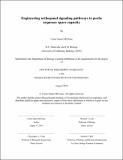Engineering orthogonal signaling pathways to probe sequence space capacity
Author(s)
McClune, Conor James.
Download1138019425-MIT.pdf (13.70Mb)
Other Contributors
Massachusetts Institute of Technology. Department of Biology.
Advisor
Michael T. Laub and Christopher A. Voigt.
Terms of use
Metadata
Show full item recordAbstract
Gene duplication is a common and powerful mechanism by which cells create new signaling pathways, but recently duplicated proteins typically must become insulated from each other, and from other paralogs, to prevent unwanted cross-talk. A similar challenge arises when new sensors or synthetic signaling pathways are engineered within cells or transferred between genomes. How easily new pathways can be introduced into cells depends on the density and distribution of paralogous pathways in the sequence space defined by their specificity-determining residues. Here, I directly probe how crowded sequence space is by generating novel two-component signaling proteins in Escherichia coli using cell sorting coupled to deep-sequencing to analyze large libraries designed based on coevolution patterns. I produce 58 new insulated pathways, in which functional kinase-substrate pairs have different specificities than the parent proteins, and demonstrate that several new pairs are orthogonal to all 27 paralogous pathways in E. coli. Additionally, I readily identify sets of 6 novel kinase-substrate pairs that are mutually orthogonal to each other, significantly increasing the two-component signaling capacity of E. coli. These results indicate that sequence space is not densely occupied. The relative sparsity of paralogs in sequence space suggests that new, insulated pathways can easily arise during evolution or be designed de novo. I demonstrate the latter by engineering a new signaling pathway in E. coli that responds to a plant cytokinin without cross-talk to extant pathways. The work in this thesis also demonstrates how coevolution-guided mutagenesis and sequence-space mapping can be used to design large sets of orthogonal protein-protein interactions.
Description
This electronic version was submitted by the student author. The certified thesis is available in the Institute Archives and Special Collections. Thesis: Ph. D., Massachusetts Institute of Technology, Department of Biology, 2019 "August 2019." Cataloged from student-submitted PDF version of thesis. Includes bibliographical references.
Date issued
2019Department
Massachusetts Institute of Technology. Department of BiologyPublisher
Massachusetts Institute of Technology
Keywords
Biology.